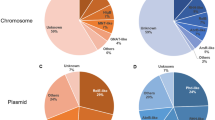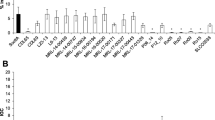Abstract
The polymorphism of 5 stress response genes (hrcA, ctsR, clpP, ftsH, dnaK) in 32 Lactobacillus plantarum strains was evaluated by multilocus restriction typing (MLRT) and by sequence analysis of ctsR, hrcA and clpP genes. Both these approaches allowed the discrimination of the subspecies L. plantarum ssp. plantarum and L. plantarum ssp. argentoratensis. HrcA sequence analysis also allowed discrimination at the species and subspecies level of several species of lactic acid bacteria, thus confirming that it can be used as a valuable taxonomic marker. No significant relationship was found between stress response gene polymorphism and resistance to heat treatments. The effect of temperature on growth kinetics and the protein expression were investigated for selected strains carrying different mutations in hrcA. L. plantarum ssp. argentoratensis NCIMB12120 and L. plantarum ssp. plantarum DPC2159, both of which had mutations in domains of HrcA which are important for the repressor functionality, had a reduced growth rate at all temperatures tested (25, 30, 37, 40, and 42 °C) compared to L. plantarum WCFS1. In L. plantarum DPC2159, protein expression upon temperature shifts from 25 to 40 °C or growth at 40 °C was altered compared to L. plantarum WCFS1, but further study is needed to unequivocally confirm the relationship with mutations in hrcA.




Similar content being viewed by others
References
Ahmad S, Selvapandiyan A, Bhatnagar RK (1999) A protein-based phylogenetic tree for Gram-positive bacteria derived from hrcA, a unique heat-shock regulatory gene. Int J Syst Bacteriol 49:1387–1394
Baranyi J, Le Marc Y (1996) Dmfit manual, version 2.0. Institute of Food Research, Norwich, UK
Baranyi J, Roberts TA (1994) A dynamic approach to predicting bacterial growth in food. Int J Food Microbiol 23:277–294
Bert F, Branger C, Lambert-Zechovsky N (1997) Pulsed-field gel electrophoresis is more discriminating than multilocus enzyme electrophoresis and random amplified polymorphic DNA analysis for typing pyogenic streptococci. Curr Microbiol 34:226–229
Blaiotta G, Fusco V, Ercolini D, Aponte M, Pepe O, Villani F (2008) Lactobacillus strain diversity based on partial hsp60 gene sequences and design of PCR restriction fragment length polymorphism assays for species identification and differentiation. Appl Environ Microbiol 74:208–215
Borgo F, Ricci G, Manachini PL, Fortina MG (2007) Multilocus restriction typing: a tool for studying molecular diversity within Lactobacillus helveticus of dairy origin. Int Dairy J 17:336–342
Cai H, Rodríguez BT, Zhang W, Broadbent JR, Steele JL (2007) Genotypic and phenotypic characterization of Lactobacillus casei strains isolated from different ecological niches suggests frequent recombination and niche specificity. Microbiology 153:2655–2665
De Angelis M, Gobbetti M (2011) Stress responses of lactobacilli. In: Papadimitriou K, Tsakalidou E (eds) Stress responses of lactic acid bacteria. Springer, New York, pp 219–249
de las Rivas B, Marcobal A, Muñoz R (2006) Development of a multilocus sequence typing method for analysis of Lactobacillus plantarum strains. Microbiology 152:85–93
Fiocco D, Capozzi V, Collins M, Gallone A, Hols P, Guzzo J, Weidmann S, Rieu A, Msadek T, Spano G (2010) Characterization of the CtsR stress response regulon in Lactobacillus plantarum. J Bacteriol 192:896–900
Goh SH, Potter S, Wood JO, Hemmingsen SM, Reynolds RP, Chow AW (1996) HSP60 gene sequences as universal target for microbial species identification: studies with coagulase-negative staphylococci. J Clin Microbiol 34:818–823
Guidone A, Zotta T, Ross RP, Stanton C, Rea MC, Parente E, Ricciardi A (2014) Probiotic properties in Lactobacillus plantarum: a multivariate screening study. LWT Food Sci Technol 56:69–76
Hill JE, Penny SL, Crowell KG, Goh SH, Hemmingsen SM (2004) cpnDB: a chaperonin sequence database. Genome Res 14:1669–1675
Huang CC, Lee FL, Liou JS (2010) Rapid discrimination and classification of the Lactobacillus plantarum group based on a partial dnaK sequence and DNA fingerprinting techniques. Antonie Van Leeuwenhoek J Microbiol 97:289–296
Hunter PR, Gaston MA (1988) Numerical Index of the discriminatory ability of typing systems: an application of Simpson’s index of diversity. J Clin Microbiol 26:2465–2466
Karatzas KAG, Wouters JA, Gahan CGM, Hill C, Abee T, Bennik MHJ (2003) The CtsR regulator of Listeria monocytogenes contains a variant glycine repeat region that affects piezotolerance, stress resistance, motility and virulence. Mol Microbiol 49:1227–1238
Kleerebezem MJ, Boekhorst R, van Kranenburg D, Molenaar OP, Kuipers R, Leer R, Tarchini SA, Peters HM, Sandbrink MW, Fiers W, Stiekema RM, Lankhorst PA, Bron SM, Hoffer MN, Groot R, Kerkhoven M, de Vries B, Ursing WM, de Vos Siezen RJ (2003) Complete genome sequence of Lactobacillus plantarum WCFS1. Proc Natl Acad Sci USA 100:1990–1995
Librado P, Rozas J (2009) DnaSP v5: a software for comprehensive analysis of DNA polymorphism data. Bioinformatics 25:1451–1452
Liu J, Huang C, Shin D-H, Yokota H, Jancarik J, Kim J-S, Adams PD, Kim R, Kim S-H (2005) Crystal structure of a heat-inducible transcriptional repressor HrcA from Thermotoga maritima: structural insight into DNA binding and dimerization. J Mol Biol 350:987–996
Molenaar D, Bringel F, Schuren FH, de Vos WM, Siezen RJ, Kleerebezem M (2005) Exploring Lactobacillus plantarum genome diversity by using microarrays. J Bacteriol 187:6119–6127
Morett E, Segovia L (1993) The sigma 54 bacterial enhancer-binding protein family: mechanism of action and phylogenetic relationship of their functional domains. J Bacteriol 175:6067–6074
Parente E, Ciocia F, Ricciardi A, Zotta T, Felis GE, Torriani S (2010) Diversity of stress tolerance in Lactobacillus plantarum, Lactobacillus pentosus and Lactobacillus paraplantarum: a multivariate screening study. Int J Food Microbiol 144:270–279
Ricciardi A, Parente E, Guidone A, Ianniello R, Zotta T, Abu Sayem SM, Varcamonti M (2012) Genotypic diversity of stress response in Lactobacillus plantarum, Lactobacillus paraplantarum and Lactobacillus pentosus. Int J Food Microbiol 157:278–285
Robbe-Saule V, Algorta G, Rouilhac I, Norel F (2003) Characterization of the RpoS status of clinical isolates of Salmonella enterica. Appl Environ Microbiol 69:4352–4358
Robey M, Benito A, Hutson RH, Pascual C, Park SF, Mackey BM (2001) Variation in resistance to high hydrostatic pressure and rpoS heterogeneity in natural isolates of Escherichia coli O157:H7. Appl Environ Microbiol 67:4901–4907
Santos Pontes D, Lima-Bittencourt CI, Chartone-Souza E, Amaral Nascimento AM (2007) Molecular approaches: advantages and artifacts in assessing bacterial diversity. J Ind Microbiol Biotechnol 34:463–473
Tamura K, Peterson D, Peterson N, Stecher G, Nei M, Kumar S (2011) MEGA5: molecular evolutionary genetics analysis using likelihood, distance, and parsimony methods. Mol Biol Evol. doi:10.1093/molbev/msr121
Tanganurat W, Quinquis B, Leelawatcharamas V, Bolotin A (2009) Genotypic and phenotypic characterization of Lactobacillus plantarum strains isolated from Thai fermented fruits and vegetables. J Basic Microbiol 49:377–385
Torriani S, Felis GE, Dellaglio F (2001) Differentiation of Lactobacillus plantarum, L. pentosus, and L. paraplantarum by recA gene sequence analysis and multiplex PCR assay with recA gene-derived primers. Appl Environ Microbiol 67:3450–3454
Wels M, Francke C, Kerkhoven R, Kleerebezem M, Siezen RJ (2006) Predicting cis-acting elements of Lactobacillus plantarum by comparative genomics with different taxonomic subgroups. Nucleic Acids Res 34:1947–1958, Erratum in: Nucleic Acids Res 34:2844
Wiegert T, Schumann W (2003) Analysis of a DNA-binding motif of the Bacillus subtilis HrcA repressor protein. FEMS Microbiol Lett 223:101–106
Zotta T, Asterinou K, Rossano R, Ricciardi A, Varcamonti M, Parente E (2009) Effect of Inactivation of stress response regulators on the growth and survival of Streptococcus thermophilus Sfi39. Int J Food Microbiol 129:211–220
Zotta T, Ricciardi A, Guidone A, Sacco M, Muscariello L, Mazzeo MF, Cacace G, Parente E (2012) Inactivation of ccpA and aeration affect growth, metabolite production and stress tolerance in Lactobacillus plantarum WCFS1. Int J Food Microbiol 155:51–59
Zotta T, Ianniello RG, Guidone A, Parente E, Ricciardi A (2013) Selection of mutants tolerant of oxidative stress from respiratory cultures of Lactobacillus plantarum C17. J Appl Microbiol 115:848–858
Zwietering MH, de Wit JC, Cuppers HG, van t Riet K (1994) Modeling of bacterial growth with shifts in temperature. Appl Environ Microbiol 60:204–213
Acknowledgments
This work was partly funded by Ministero dell’Istruzione, dell’Università e della Ricerca, Rome, Italy, PRIN n. 20088SZB9B, and by the Science Foundation of Ireland, Centre for Science, Engineering and Technology (SFI-CSET) grant 02/CE/B124. The Alimentary Pharmabiotic Centre is a research centre funded by Science Foundation Ireland (SFI).
Author information
Authors and Affiliations
Corresponding author
Electronic supplementary material
Below is the link to the electronic supplementary material.
Supplementary Table 1
(DOC 36 kb)
Supplementary Table 2
(DOC 117 kb)
Supplementary Fig. 1
(DOC 45 kb)
Supplementary Fig. 2
(DOC 82 kb)
Supplementary Fig. 3
(DOC 77 kb)
Supplementary Fig. 4
(DOC 1032 kb)
Rights and permissions
About this article
Cite this article
Guidone, A., Parente, E., Zotta, T. et al. Polymorphisms in stress response genes in Lactobacillus plantarum: implications for classification and heat stress response. Ann Microbiol 65, 297–305 (2015). https://doi.org/10.1007/s13213-014-0862-7
Received:
Accepted:
Published:
Issue Date:
DOI: https://doi.org/10.1007/s13213-014-0862-7




